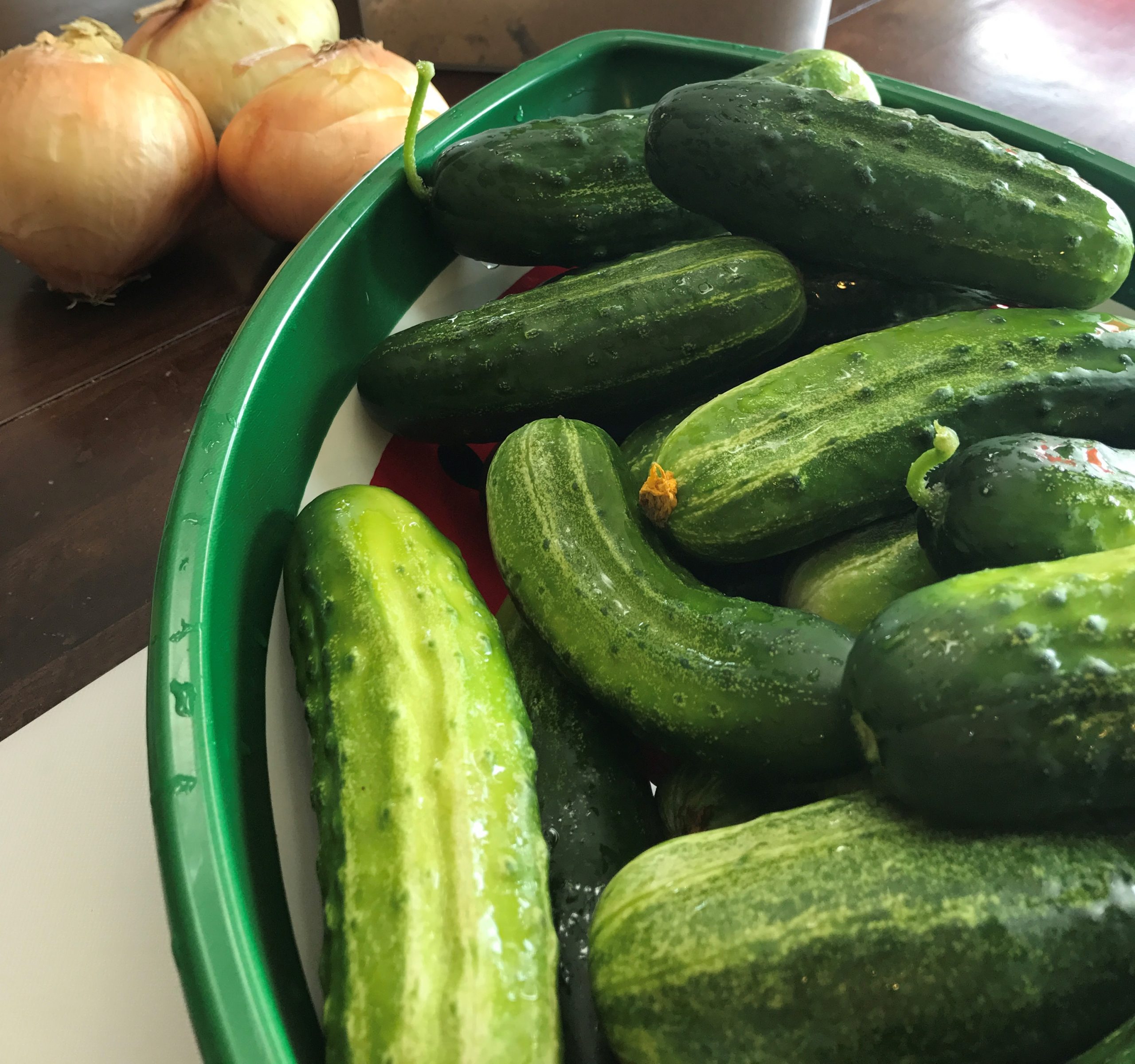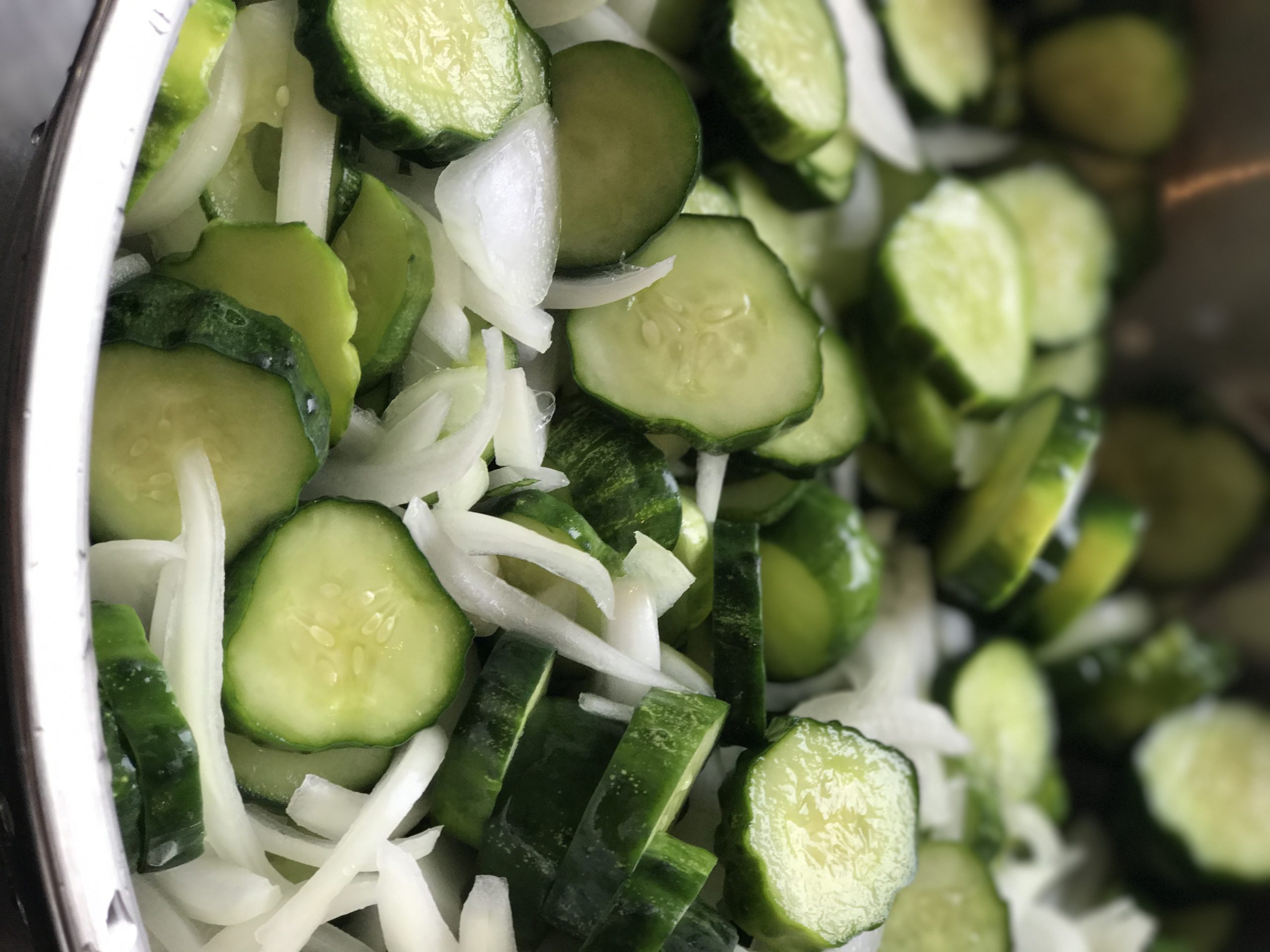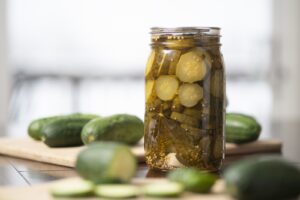Check this out!
 In the United States, the most common kinds of pickles are cucumbers and peppers preserved primarily by the use of vinegar and/or salt. They may be honeyed, sugared, peppered, dilled, garlicked, spiced, mixed, soured, and fermented. Not to mention, they come in a plethora of shapes and sizes from spears, to chopped or diced, and even whole. (I think I am starting to see where the British Bread & Butter Pickles recipe may have come from…)
In the United States, the most common kinds of pickles are cucumbers and peppers preserved primarily by the use of vinegar and/or salt. They may be honeyed, sugared, peppered, dilled, garlicked, spiced, mixed, soured, and fermented. Not to mention, they come in a plethora of shapes and sizes from spears, to chopped or diced, and even whole. (I think I am starting to see where the British Bread & Butter Pickles recipe may have come from…)
In fact, there are actually 36 different varieties of pickles to choose from and hundreds of variations processed within these 36 varieties.
In the US a pickle is a cucumber that’s been pickled (or fermented) in a brine which consists of vinegar, salt and water. We then flavor the pickle and its brine with herbs and seasonings like dill flowers (or dill seeds), garlic cloves, hot pepper flakes, mustard seeds and more. What the US calls a traditional dill pickle, the UK calls a gherkin or a dilled cucumber, or if dill is omitted from the recipe, the UK calls them a pickled cucumber. Which makes perfect sense to me seeing that is exactly what we are doing…we are pickling the cucumber.
What is a Bread & Butter Pickle?
Now, what we in the states call a sweet pickle, the UK recipe for a sweet pickle is a  chutney-like condiment made from chopped vegetables (and sometimes fruits) that are then pickled in vinegar and sugar. The main difference in the definition of the term pickle from the US to the UK is the addition and use of sugar, no matter the vegetable used. The most popular pickle in the UK is Branston pickle.
chutney-like condiment made from chopped vegetables (and sometimes fruits) that are then pickled in vinegar and sugar. The main difference in the definition of the term pickle from the US to the UK is the addition and use of sugar, no matter the vegetable used. The most popular pickle in the UK is Branston pickle.
Branston Pickles are made from a variety of diced vegetables, including swede, carrots, onions and cauliflower pickled in a sauce made from vinegar, tomato, apple and spices. In recent years high-fructose corn syrup has replaced sugar in the product sold in the American market. (Gee, thanks dear FDA. Sigh.) Sugar, however, is still used in the British version. Notice how there’s really no mention of a cucumber in the recipe but yet the recipe is called pickles? By the way, a swede is a member of the cabbage family and is often confused with a turnip. In America, we call it a rutabaga.
FUN FACTS: In 2004 the pickle Branston brand business was sold by Nestle to Premier Foods and production was moved to Bury St Edmunds in Suffolk. Premier Foods sold the brand to Mizkan, a company in Japan, in 2013, at which time it ceased to be labelled as Crosse and Blackwell because in Europe this name was sold separately to Princes Group. The pickle product sells over 17 million jars a year in the UK. Source: (Martin, K. (2017). Famous Brand Names and Their Origins. Pen & Sword Books Limited. pp. 8–9. ISBN 978-1-78159-015-7. Retrieved 27 October 2017.)
With that, bread and butter pickles are one of the hundreds of variations across the globe. A recipe I stumbled upon, called British Bread & Butter Pickles, is again a variation of the many types of bread and butter pickles in the world today. This fun play on the popular sweet pickle is a deeper colored version using brown sugar in replace of white, apple cider vinegar in replace of white vinegar and a punch of ground ginger to give the pickles a zing! The following is my adaptation to said sweet and tangy pickled cucumber recipe.
British Bread & Butter Pickles Recipe
Makes approx. 7 pints
This fun play on the popular sweet pickle is a deeper colored version using brown sugar in replace of white, apple cider vinegar in replace of white vinegar. The term “sweet pickle” is British, so I decided to give this sweet pickle a bit of “zing” by adding ground ginger. This recipe will not disappoint!
Ingredients
- 12 cups pickling cucumbers, cut into ¼” round
- 6 cups sweet onions, sliced thin
- 2/3 cup canning & pickling salt
- 4 cups apple cider vinegar
- 2 ½ cups brown sugar, packed
- 3 tablespoons mustard seeds
- 1 teaspoon celery seeds
- 2 teaspoons ground turmeric
- 2 teaspoons ground ginger
Instructions
- In a stainless steel bowl, combine cucumbers, onions and canning salt. Mix well. Cover with cold water and let sit for 2 hours at room temperature.
- In a large stainless steel stock pot, combine vinegar, sugar, mustard seeds, celery seeds, turmeric and ginger. Bring to a boil over medium high heat, stirring to dissolve the sugar.
- In a large colander in the sink, rinse cucumbers and onions thoroughly, being sure to mix well under cool running water for about 5 minutes. Vigorously shake off excess water from cucumbers and onions.
- Add rinsed and shaken cucumbers and onions to the brine in the stock pot. Mix well and return to a boil. Boil for 1 minute.
- Using a slotted spoon, fill each jar with the cucumber and onion mixture, keeping
 a ½ inch headspace. Ladle hot picking brine atop vegetables, keeping the ½ inch head space. Remove any air bubbles and add additional brine if necessary to maintain the headspace.
a ½ inch headspace. Ladle hot picking brine atop vegetables, keeping the ½ inch head space. Remove any air bubbles and add additional brine if necessary to maintain the headspace. - Wipe each jar rim with a warm, wet wash cloth dipped in vinegar. Place a lid and ring on each jar and hand tighten.
- Place jars in water bath, being sure each is covered with 1 inch of water. Bring to a boil and process pints for 10 minutes. If using quarts, process for quarts for 15 minutes. Be sure not to start your timer until the water is at a full rolling boil. After processing, wait 5 minutes before removing the jars from the canner.
Enjoy~
Diane, The Canning Diva®
www.canningdiva.com


